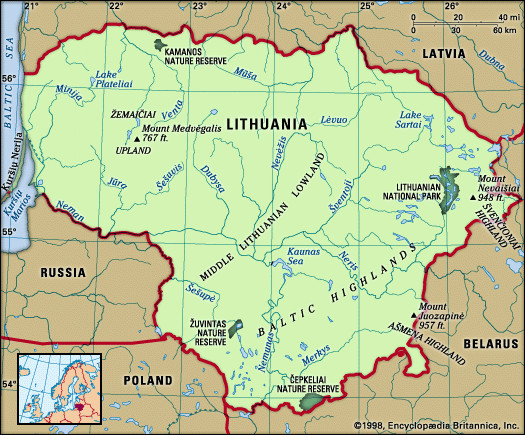Lithuania, a country often cited for its rich history and vibrant culture, is geographically positioned in Northern Europe. Specifically, it lies on the eastern shore of the Baltic Sea, making it one of the three Baltic states. To truly understand where Lithuania is, it’s essential to explore its neighboring countries and its unique geographical features that shape its identity.
Lithuania’s Location in the Baltic Region
Lithuania is nestled in the Baltic region of Europe. To its north lies Latvia, sharing a border that connects these two Baltic nations. Moving eastward and southward, Lithuania is bordered by Belarus, a large Eastern European country. Towards the southwest, Lithuania shares borders with Poland and the Kaliningrad Oblast, a detached part of Russia. Finally, to the west, Lithuania’s coastline is defined by the beautiful Baltic Sea. This strategic location has historically placed Lithuania at the crossroads of Eastern and Western Europe, influencing its culture and development.
 Detailed map highlighting the location of Lithuania in Europe and its neighboring countries.
Detailed map highlighting the location of Lithuania in Europe and its neighboring countries.
The Diverse Terrain of Lithuania: From Coastline to Highlands
The Lithuanian landscape, sculpted by Ice Age glaciers, is predominantly a low-lying plain. This glacial activity left behind moraines, ridge-like deposits that contribute to the subtle undulations of the terrain. Along the Baltic coast, a maritime depression gradually rises eastward, creating a diverse coastal environment. Sandy beaches and dunes are prominent features, and the Curonian Lagoon, a significant body of water nearly separated from the sea by the Curonian Spit, adds a unique characteristic to Lithuania’s western edge. The Curonian Spit itself is a remarkable 100-kilometer (60-mile) long sandspit, a striking natural formation.
Inland, to the east of the coastal region, lies the Žemaičiai Upland, transitioning to the expansive Middle Lithuanian Lowland. This lowland stretches across the country from north to south, characterized by glacial lake clays and loams interspersed with boulders. Some areas of this lowland are notably waterlogged, creating wetlands and contributing to Lithuania’s rich biodiversity. Further east and southeast, the Baltic Highlands emerge, contrasting with the flatness of the lowland. This elevated region features a rolling glacial terrain, dotted with hills and numerous lakes, adding to the scenic beauty of eastern Lithuania. Within the Ašmena Highlands, Mount Juozapinė stands as the highest point in Lithuania, reaching 292 meters (957 feet) above sea level.
Rivers and Lakes: Lithuania’s Waterways
Lithuania’s rivers are integral to its landscape, all flowing into the Baltic Sea. These rivers are typical of lowland regions, characterized by their slow, meandering courses. The Neman River (Nemunas), the largest river in Lithuania, flows through the heart of the country, initially northward and then westward. Its tributaries, including the Merkys, Neris, Nevėžis, Dubysa, Jūra, Minija, and Šešupė, form a network of waterways across the nation. Adding to Lithuania’s aquatic charm are its numerous lakes, approximately 3,000 in total, predominantly located in the eastern and southeastern parts of the country. These lakes, along with boggy regions, contribute to the production of peat, a significant natural resource used in both industry and agriculture within Lithuania.
Soil and Climate: Influences on Lithuanian Life
Lithuanian soils vary across the country, ranging from sandy to heavy clay compositions. The northwest region features loamy and sandy soils, often marshy and significantly podzolized, meaning they are leached of nutrients. Central Lithuania is characterized by weakly podzolized loamy peats, which are the most fertile soil types in the country, making this region ideal for cultivation and agriculture. In contrast, southeastern Lithuania has sandy, somewhat loamy, and moderately podzolized soils. Sandy soils are extensive, covering about a quarter of Lithuania, and are largely covered by woodlands, reflecting the interplay between soil type and vegetation.
Lithuania’s climate is transitional, blending maritime influences from Western Europe with the continental climate of Eastern Europe. This results in a climate dominated by damp Atlantic air masses, interspersed with Eurasian continental air and, less frequently, Arctic or southern tropical air. The Baltic Sea exerts a significant influence, particularly in the coastal zone. January, the coldest month, sees average temperatures around -5 °C (low 20s F), while July, the warmest month, averages around 17 °C (60s F). Annual rainfall typically exceeds 800 mm (30 inches), decreasing as you move inland. Rainfall peaks in August, except along the coast, where it peaks a couple of months later due to maritime effects.
Flora and Fauna: Lithuania’s Biodiversity
Lithuania’s plant life is diverse, divided into three main regions. Maritime areas are dominated by pine forests, with wild rye and shrubbery on the dunes. Spruce forests are prevalent in the hilly eastern region. Central Lithuania is characterized by oak forests, birch forests in the north, and black alder and aspen groves. Pine forests are also common in the south. Overall, about one-third of Lithuania is forested, and another fifth is meadowland, showcasing a rich natural landscape.
Lithuanian wildlife is equally diverse, including a variety of mammals. Wolves, foxes, otters, badgers, ermine, wild boars, and rodents are found throughout the country. The deep forests are habitats for elk, stags, deer, beavers, mink, and water rats. Birdlife is abundant, with hundreds of species, including white storks, ducks, geese, swans, cormorants, herons, hawks, and occasionally bald eagles. Grouse and partridge are also common, contributing to a vibrant ecosystem.
Conclusion: Lithuania’s Geographical Identity
In conclusion, “Where Is Lithuania?” is answered by understanding its Baltic Sea location, its neighboring countries, and its varied geography. From its sandy coast and the unique Curonian Spit to its glacial plains, highlands, and numerous rivers and lakes, Lithuania’s geographical features are diverse and captivating. This Baltic nation’s location and landscape have shaped its environment, culture, and history, making it a geographically significant and fascinating country in Northern Europe.

